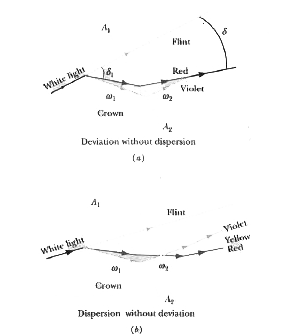Deviation without dispersion and disperison without deviation
What should be the condition on a combination of prism for the following ?
(a) Angle of dispersion is zero but angle of deviation is not zero.
Text Solution
(1) Deviation without dispersion is not possible for a single prism but we can combine two or more prisms so that dispersion is zero. Such a combination is known as achromatic combination of prisms.
(2) Mathematically we want that
δ1+δ2≠0,
but in this case
θ1+θ2=0
Calculation We have
(nv1−nR1)A1+(nV2−nR2)A2=0
Since nV−nR is always greater than 0, this is possible only where A1 and A2 are of the opposite signs. That is,
A2=−(nV1−nR1nV2−nR2)A1
Now,
δ=δ1+δ2
=(nV1−1)A1+(nv2−1)A2
=(nV1−1)A1−(nV2−1)(nV1−nR1nV2−nR2)A1
=(nV1−1)A1[1−(nV1−nR1nV1−1))(nV1−1nV2−nR2)]
=δ1[1−ω1ω2]
(b) Angle of deviation is zero but angle of dispersion is not zero.
(1) Dispersion without deviation is not possible for a single prism but we can combine two or more prisms so that deviation is zero. Such a combination is known as direct vision prism.
(2) Mathematically we want that
δ1+δ2=0
but in this case
θ1+θ2≠0
Calculation we know that
δ=δ1+δ2=0
where δ is average deviation for each prism , that is
(nV1−1)A1+(nV1−1)A2=0
A2=−(nY1−1)A1)(ny1−1)
This would mean that in this case also both angles of the prism are of opposite signs.
θ=θ1+θ2
Now,
θ1=(nv1−nR1A1
θ2=(nv2−nR2A2
θ=(nV1−nR1)A1−(nV2−nR2)(nV1−1)A1(nV2−1)
Substituting the value of A2, we get
(nV1−nR1)[1−[(nV2−nR2nY1−1)(nY2−1nV1−nR2)]]
Finally, we have
θ=θ1+θ2=θ1[1−ω2ω1]
(Only yellow color ray will not deviate, all other colored rays will deviate
Learn : This kind of combination of prisms is possible only if the prisms are kept inverted with respect to each other as shown in the Fig. 34-67.

|
Topper's Solved these Questions
- GEOMETRICAL OPTICS : REFRACTIONBOOK - RESNICK AND HALLIDAYCHAPTER - GEOMETRICAL OPTICS : REFRACTIONEXERCISE - Check point
6 Videos
- GEOMETRICAL OPTICS : REFRACTIONBOOK - RESNICK AND HALLIDAYCHAPTER - GEOMETRICAL OPTICS : REFRACTIONEXERCISE - Problems
44 Videos
- GEOMETRICAL OPTICS : REFLECTION BOOK - RESNICK AND HALLIDAYCHAPTER - GEOMETRICAL OPTICS : REFLECTION EXERCISE - PRACTICE QUESTIONS (Integer Type)
3 Videos
- GRAVITATIONBOOK - RESNICK AND HALLIDAYCHAPTER - GRAVITATIONEXERCISE - PRACTICE QUESTIONS (INTEGER TYPE)
4 Videos
Similar Questions
Knowledge Check
In dispersion without deviation
AThe emergent rays of all the colours are parallel to the incident rayBYellow coloured ray is parallel to the incident rayCOnly red coloured ray is parallel to the incident rayDAll the rays are parallel, but not parallel to the incident rayThe net angular dispersion without deviation is equal to
Aδ(1−ωω′)Bδ(1−ω′ω)Cδ(ω′−ω)Dδ(ω−ω′)The arrngement of dispersion without deviation is used in ____
Adirect vision spectroscopyBindirect spectroscopyCbinocular visionDperiscope
Is deviation always followed by dispersion ?
View SolutionDispersion by a prism||Dispersion without deviation||Deviation without dispersion||Examples on dispersion
View SolutionProblems on Prism||Angular Dispersion||Dispersion without Deviation||Deviation without Dispersion
View SolutionPrism||Dispersion||Deviation
View SolutionMinimum Deviation||Thin Prism||Dispersion Without Deviation||Deviation Without Dispersion
View Solution
